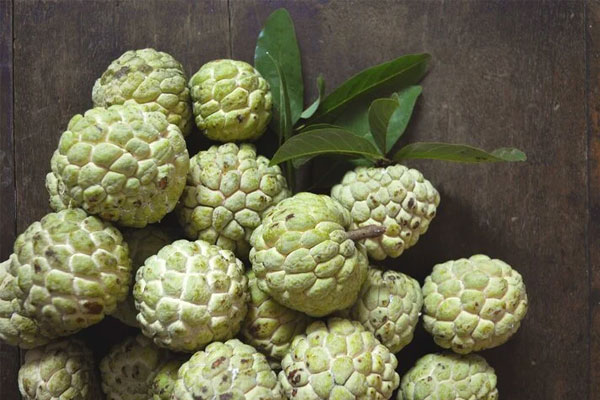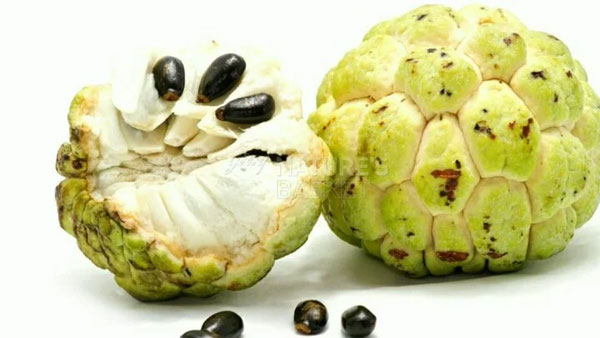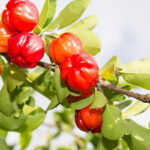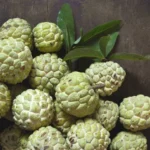The sugar apple, or Annona reticulata, is a tropical fruit belonging to the custard apple family. This delicious treat is packed with nutrients, particularly vitamin C. A 120g serving (approximately half a medium-sized fruit) provides 38% of your daily vitamin C needs, along with good amounts of magnesium, vitamin B6, and iron.
Tips for Choosing Naturally Ripe Sugar Apples
Picking the perfect sugar apple can be a challenge, especially when it comes to avoiding those that have been chemically ripened. The following tips will help you select naturally ripe fruit that is both delicious and safe to eat.
Observe the Exterior
One of the first signs of a naturally ripe sugar apple is its appearance. As the fruit matures on the tree, the skin will begin to crack, revealing the white flesh beneath through the opening eyes. This is a clear indication that the sugar apple is at its sweetest and most fragrant.
Naturally ripe sugar apples typically have a light green or greenish-yellow hue. Darker green fruits are likely unripe or chemically ripened. Sometimes, naturally ripe sugar apples develop small black spots on their skin, which is perfectly normal and doesn’t affect the quality of the fruit.
Ripe sugar apples have a soft, yielding texture. Gently press the fruit with your thumb; if it gives way slightly and bounces back, it’s likely naturally ripe. Hard, unyielding fruits may be unripe or chemically treated.
 Naturally ripe sugar apples will have cracking skin and open eyes, revealing the white flesh. (Photo: Green Cloud Solutions)
Naturally ripe sugar apples will have cracking skin and open eyes, revealing the white flesh. (Photo: Green Cloud Solutions)
Examine the Stem
The stem of a sugar apple is also a good indicator of its ripeness. Naturally ripe fruits tend to have fresh, green stems that are not wilted or dry. A wilted or dry stem could mean the fruit was picked unripe and then chemically ripened.
Sometimes, chemically ripened sugar apples have damaged stems that turn brown due to rough handling or transportation. Choose fruits with intact, undamaged stems to ensure they are naturally ripe.
Smell the Fruit
Don’t underestimate the power of your sense of smell when choosing sugar apples. Naturally ripe fruits have a distinctive, pleasant aroma that is not overpowering. You can smell the stem or the skin to check for this fragrance. If the fruit has a strong, pungent, or strange odor, it may be chemically ripened or past its prime.
Feel the Weight
The weight of a sugar apple can also give you clues about its ripeness. A heavier fruit, relative to its size, usually indicates a naturally ripe sugar apple with plenty of juicy flesh. Lighter fruits may be less ripe or have drier flesh.
Look for sugar apples that are evenly soft, with a moderate firmness. Avoid fruits that are too soft or mushy, as they may be overripe or spoiled.
Check the Seeds
 Ripe sugar apples have black, shiny seeds that are easy to remove from the flesh. (Photo: Neelus World)
Ripe sugar apples have black, shiny seeds that are easy to remove from the flesh. (Photo: Neelus World)
Another quick way to check the ripeness of a sugar apple is to look at its seeds. Naturally ripe fruits will have black, shiny seeds that are easy to remove from the flesh. If the seeds are pale, gray, or unevenly colored, the fruit has likely been chemically ripened.
When tasting, naturally ripe sugar apples have soft, sweet flesh with a mild flavor. Chemically ripened fruits tend to have tougher flesh and may not be as sweet.
Buy from Reputable Sources
To ensure you’re getting naturally ripe sugar apples, it’s best to buy from reputable stores, supermarkets, or trusted vendors. If possible, purchase directly from farmers at local markets.
Sugar apples are typically in season during the fall, from August to October. Buying during this period increases your chances of finding naturally ripe fruits at their most flavorful.
Source: VTC
How to Choose Sweet, Nutritious Strawberries
Cherries are a nutrient-rich fruit with a myriad of beauty and health benefits. They are known to possess anti-aging and antioxidant properties and play a crucial role in boosting the immune system, protecting the body, and reducing fatigue. But how do you choose the sweetest and most delicious cherries? This introduction aims to guide you through simple yet effective methods to select the perfect cherries every time.
What are the Different Types of Shiseido’s Liquid Collagen and How Much Do They Cost?
The market is flooded with countless collagen products, but Shiseido’s liquid collagen continues to be a trusted choice for many. Join us as we delve into the world of Shiseido’s liquid collagen offerings, exploring the different types available and their prices. We’ll help you navigate this renowned brand’s range to discover which products are truly worth your investment.






































